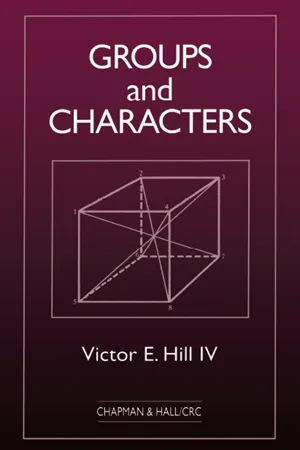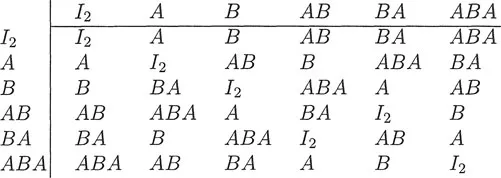
This is a test
- 239 pages
- English
- ePUB (mobile friendly)
- Available on iOS & Android
eBook - ePub
Groups and Characters
Book details
Book preview
Table of contents
Citations
About This Book
Group representation theory is both elegant and practical, with important applications to quantum mechanics, spectroscopy, crystallography, and other fields in the physical sciences. This book offers an easy-to-follow introduction to the theory of groups and of group characters. Designed as a rapid survey of the subject, it emphasizes examples and applications of the theorems, and avoids many of the longer and more difficult proofs. The text includes sections that provide the mathematical basis for some of the applications of group theory. It also offers numerous exercises, some stressing computation of concrete examples, others stressing development of the theory.
Frequently asked questions
At the moment all of our mobile-responsive ePub books are available to download via the app. Most of our PDFs are also available to download and we're working on making the final remaining ones downloadable now. Learn more here.
Both plans give you full access to the library and all of Perlego’s features. The only differences are the price and subscription period: With the annual plan you’ll save around 30% compared to 12 months on the monthly plan.
We are an online textbook subscription service, where you can get access to an entire online library for less than the price of a single book per month. With over 1 million books across 1000+ topics, we’ve got you covered! Learn more here.
Look out for the read-aloud symbol on your next book to see if you can listen to it. The read-aloud tool reads text aloud for you, highlighting the text as it is being read. You can pause it, speed it up and slow it down. Learn more here.
Yes, you can access Groups and Characters by Victor E Hill in PDF and/or ePUB format, as well as other popular books in Mathematics & Mathematics General. We have over one million books available in our catalogue for you to explore.
Information
Chapter 1
Introductory Examples
To introduce some of the fundamental concepts of group theory in a concrete context, we’ll begin with some examples. The terminology introduced informally in this section will be given precise definition in later sections. The object here is to gain a sense of what one thinks about in group theory.
1.1 Example: A matrix group
Consider the matrices:
Here we find
the 2 ×2 identity matrix. We’ll say that A and Β have order 2 since the square of each is the identity of the operation under consideration, that of matrix multiplication. Now compute products:
you can easily check that (AB)2 = BA and that (AB)3 = Ι2. Since the cube of AB is the identity matrix I2, we’ll say that AB has order 3. You could compute (BA)3 directly or, alternatively, observe that
either way we see that BA also has order 3.
So far we have found five matrices (including the identity) using the A and Β with which we started. Are others possible? At least
can be added to the list since it has not yet been accounted for. To see whether or not others are needed, let’s tabulate what we have so far in the form of a multiplication table. We will be able to fill in some of the entries by algebraic computations such as
others, such as Β (AB), can be found by matrix multiplication, where it turns out that Β (AB) = ABA, a matrix already on our list.

Note that we were able to complete an entire table without adding any matrices to our list of six. We’ll say that the set
together with the operation of matrix multiplication forms a group, which we may denote by G. Here the letter G is understood to refer to the set of six matrices together with the operation of matrix multiplication. Since the set has six elements, G is called a group of order 6.
We have used the term order both to designate the number of elements in a group and to specify the smallest positive power of a group element that equals the identity. These two usages will be connected in Proposition 2.11.
1.2 Example: A symmetry group
Consider the solid shown in Figure 1.1; it is called a trigonal bipyramid. The vertices have been numbered from 1 to 5. Now we move this solid in space in such a way that the geometric appearance of the solid in space is retained, but the vertices may have been interchanged. For example, if we rotate the solid through 120° about a vertical axis through vertices 1 and 5, those two vertices remain where they were, but 2 goes to the place formerly occupied by 3, 3 t...
Table of contents
- Cover
- Title Page
- Copyright Page
- Dedication
- Table of Contents
- Preface
- 1 Introductory Examples
- 2 Groups and Subgroups
- 3 Point Groups and Cosets
- 4 Homomorphisms and Normal Subgroups
- 5 Isomorphisms and Automorphisms
- 6 Factor Groups
- 7 Sylow Subgroups
- 8 Permutation Groups
- 9 Matrix Groups
- 10 Group Representations
- 11 Regular Representations
- 12 Irreducible Representations
- 13 Representations of Abelian Groups
- 14 Group Characters
- 15 Orthogonality Relations and Character Tables
- 16 Reducible Characters
- 17 The Burnside Counting Theorem
- 18 Real Characters
- 19 Induced Characters
- 20 The Character Table for S5
- 21 Space Groups and Semidirect Products
- 22 Proofs of the Sylow Theorems
- Bibliography
- Index of Symbols
- Index